The day we spent visiting the archaeological site Hampi has remained in my memory as probably the most beautiful day during this journey around India, at least as far as the weather is concerned. It was utterly beautiful. Although it was sunny and warm, we did not have any feeling of unpleasantness caused by possible air humidity and high temperature since all the time there was a breeze cooling us down.
While we were within the Royal Enclosure, we climbed an elevated platform called Mahanavami.
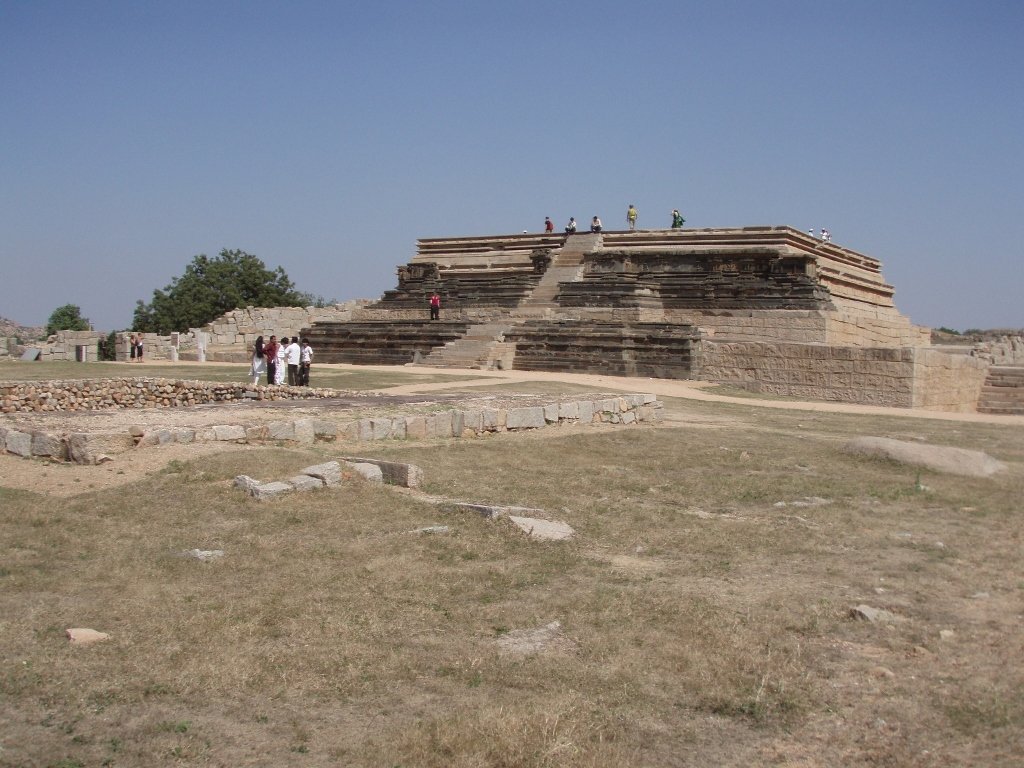 Mahanavami Platform
Mahanavami Platform
In the past, the platform was used by kings while watching pre-war ceremonies, as well as during the celebration of Mahanavami festival which is even today celebrated in the state of Karnataka, but is now called the Royal Dasara. This festival celebrates the victory of goddess Durga over a buffalo demon called Mahishasura. I keep mentioning these different names of deities and divine beings, not necessarily because I know them by heart, but rather because one keeps coming across them in different temples throughout India and it’s not a bad thing for one to start slowly getting used to those terms and different divine situations that are the subject of various visual depictions.
Mahanavami Platform is 12 metres high and has a square ground plan with each side being 40 metres long. The top of the platform that gradually narrows down is reached by rather high steps and those different levels made of stone are impressively decorated with reliefs.
There we also saw two leaves of a stone door that have survived centuries and that now lie down resting laterally against special supports in the form of small stone walls.
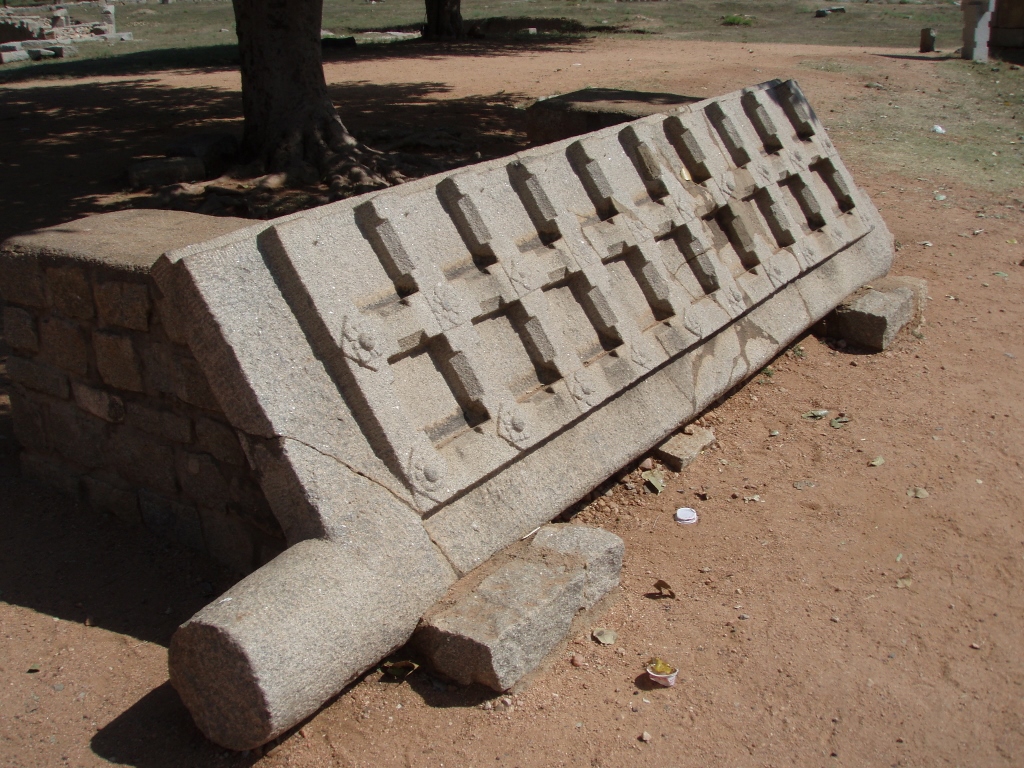 One of the stone door’s leaves
One of the stone door’s leaves
And then we also went to the Queen’s Bath. This is a structure the centre of which is open, i.e., without the roof and it is presumed that it was built for the royal family’s women in order for them to have fun there. Hence the name, although it is also presumed that this place was used for the bathing and pleasure of the king and his queens (yes, yes, the queens in plural!).
The structure that has a rectangular ground plan is yet another that was built in the Indo-Islamic style of architecture and it was very interesting to see the huge contrast between the simplicity of the building from the outside and the level of decoration on the inside.
Since there used to be a very impressive network of aqueducts in Hampi, there was fresh water supply provided for this building as well. In the centre of the structure there is an open-air pool that is 1.8 metres deep, which means that it was possible to jump in, but there are certainly stairs for slow and gradual entering into the water. But, this thing with jumping into the water is just my comment. I have actually no idea if the queens were keen on doing that. It would certainly ruin their hair.
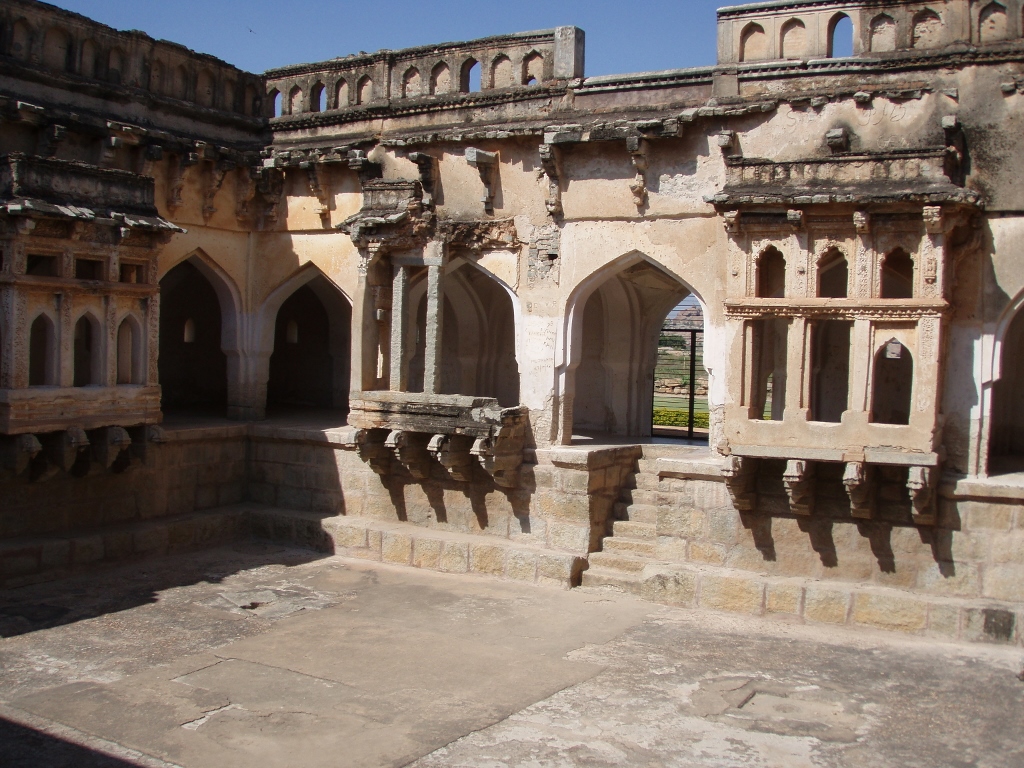 The Queen’s Bath
The Queen’s Bath
And then, as the final destination during our visit to Hampi, we went to visit Vitthala Temple that is perhaps the most magnificent temple here at the seat of the former Vijayanagara Empire.
To start with, I faced a very unpleasant problem. Namely, the battery in my photo-camera was empty. That was not good. However, in front of the entrance into the Vitthala Temple complex there is a ticket office and while Sneža was handling the money and the change I had a genius idea and it all worked out: I asked the people working at the ticket office if I could leave my battery to be charged there, since I happened to have the charger on me. While I was visiting the temple filming it with my video camera, I also memorised the places I would like to have a photo of. Once my visit was over, I went back to the ticket office, took my photo camera with the refreshed battery, went back to the temple and there I revisiting everything quickly taking photos along the way. When one travels, it is important to be resourceful and I was very proud of myself for finding a solution, while I was also immensely grateful to the people working at the ticket office.
The Vitthala Temple complex is rather big and within the area surrounded by a wall there are several temples and structures. To begin with, one enters through a gate above which there is the specific tower called the gopuram.
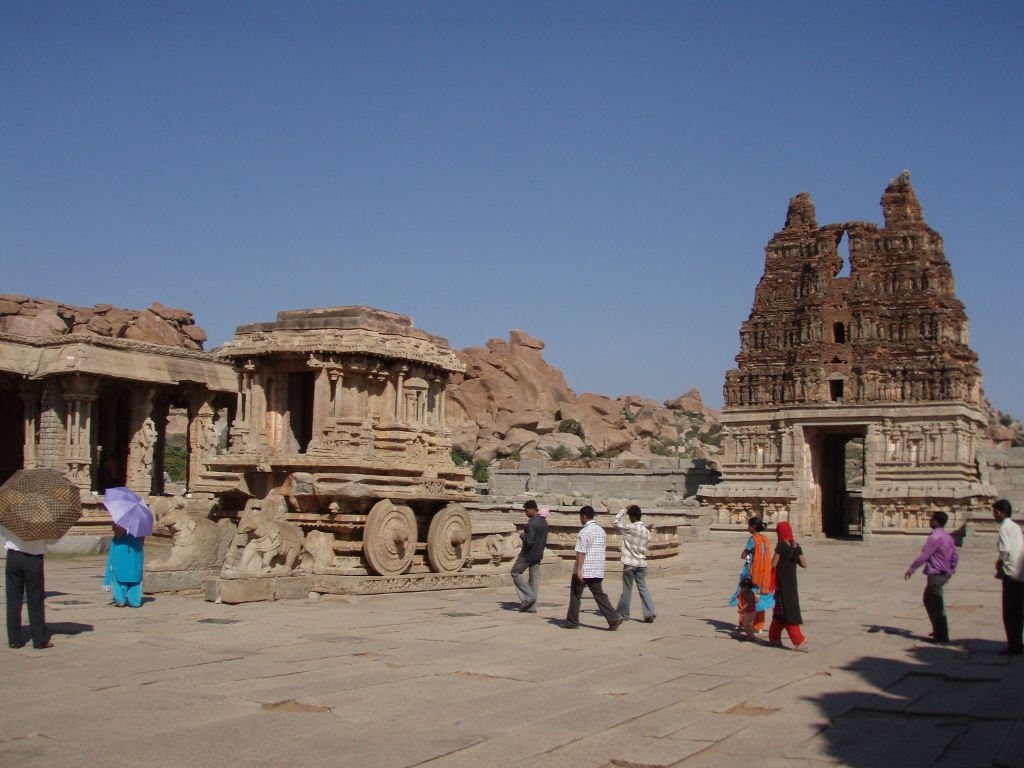 Vitthala Temple, the entrance and the gopuram are to the right, and the Stone Chariot is to the left
Vitthala Temple, the entrance and the gopuram are to the right, and the Stone Chariot is to the left
The temple dates back to the 15th century, with some additions and extensions done in the 16th century and it constitutes the pinnacle of the arts and architecture of the Vijayanagara Empire. It is dedicated to Vitthala who is the most important form of Krishna, and this one in turn is a very much revered deity in his own right, as well as the eighth avatar of god Vishnu, which indirectly means that Vitthala Temple is actually dedicated to Lord Vishnu. This is seen precisely by the Stone Chariot in the courtyard that itself is a type of shrine. The coach is dedicated to Garuda and according to the Hindu mythology Garuda, half-man half-eagle, is the vehicle or the carrier of Lord Vishnu.
The central temple, i.e., most of its interior was being restored at the time when Sneža and I were there, but we still managed to enter into a smaller section of the interior in the back of the temple, plus the temple is completely fascinating from the outside and this in itself was enough for me to enjoy thoroughly.
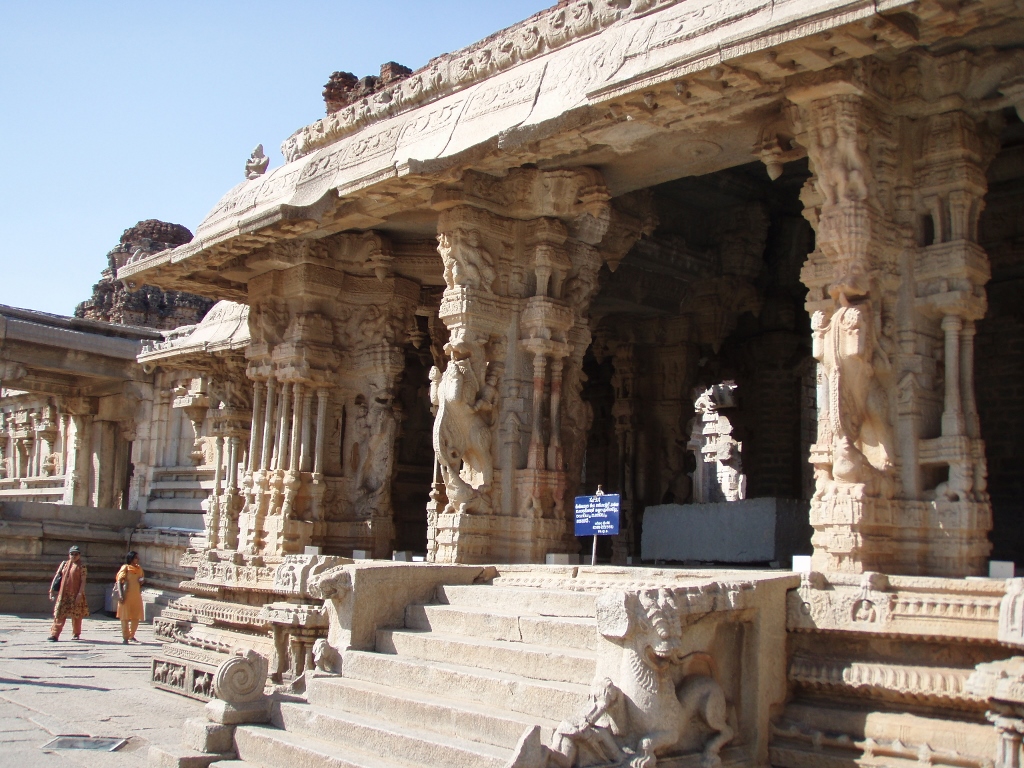 Vitthala Temple, the central temple
Vitthala Temple, the central temple
In addition to the exquisitely decorated platform that is used as the base for the temple, the nicely carved pillars that the staircase leads to are also decorated with the yali, the mythical animals that are here shown in the shape of lions reared on their hind legs.
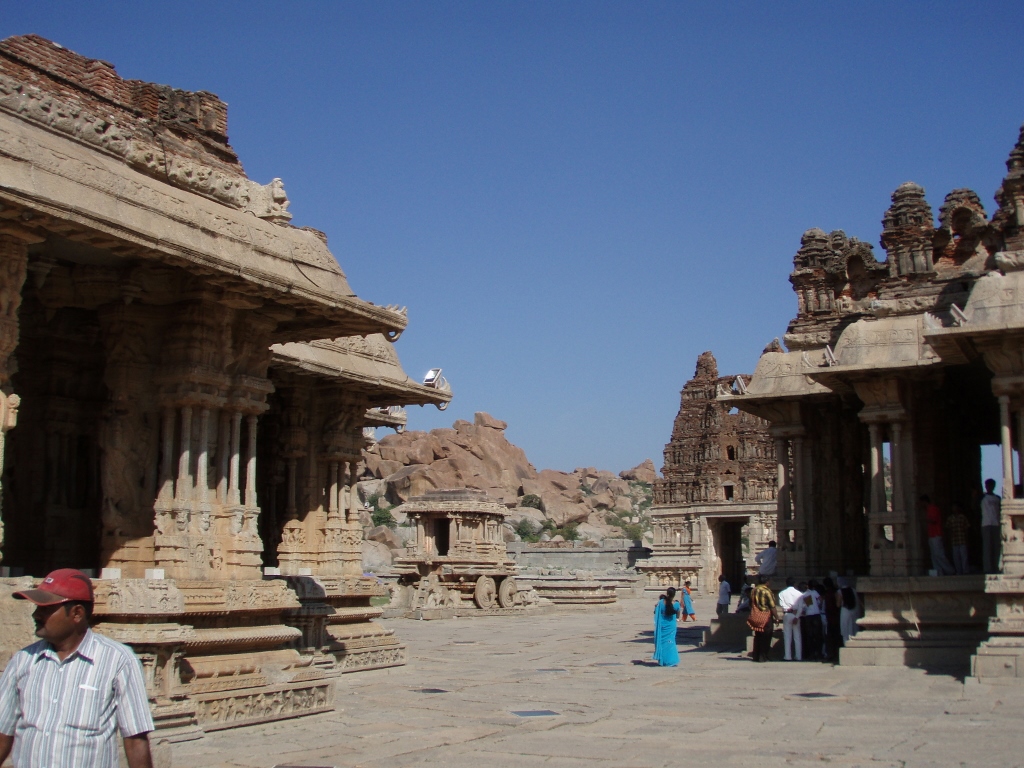 Vitthala Temple, from the left to the right: the central temple, Stone Chariot, entrance with the gopuram and one of the side temples
Vitthala Temple, from the left to the right: the central temple, Stone Chariot, entrance with the gopuram and one of the side temples
This temple is also decorated with the so-called music pillars. Namely, around the main pillars that carry the roof structure, there are numerous slender stone pillars. They were made so specifically that when they are gently tapped, they create s certain music tone. And not only that, but around the main pillars within the mandapa (the mandapa is the name for the open hall the interior of which is filled with pillars) there are seven slim pillars and each one of them has its own specific tone that is different from the others. Needless to say, the tourists are informed that they should not all start banging on the pillars, since that would certainly destroy them.
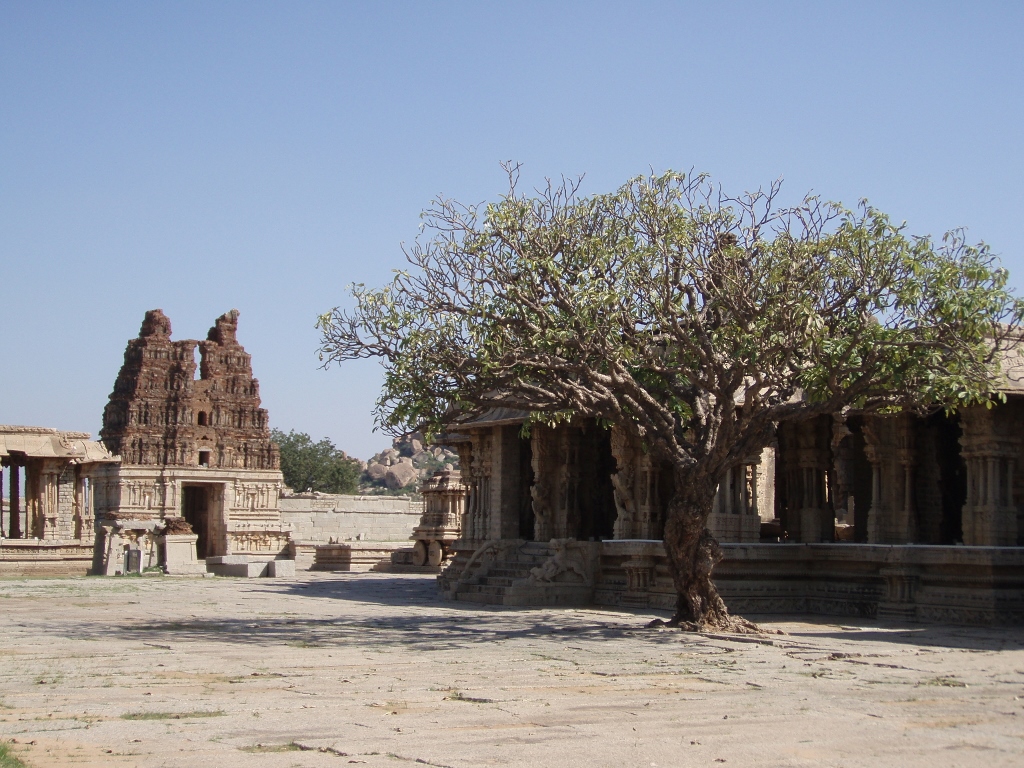 Vitthala Temple; main entrance with the gopuram, a part of the Stone chariot and the central temple
Vitthala Temple; main entrance with the gopuram, a part of the Stone chariot and the central temple
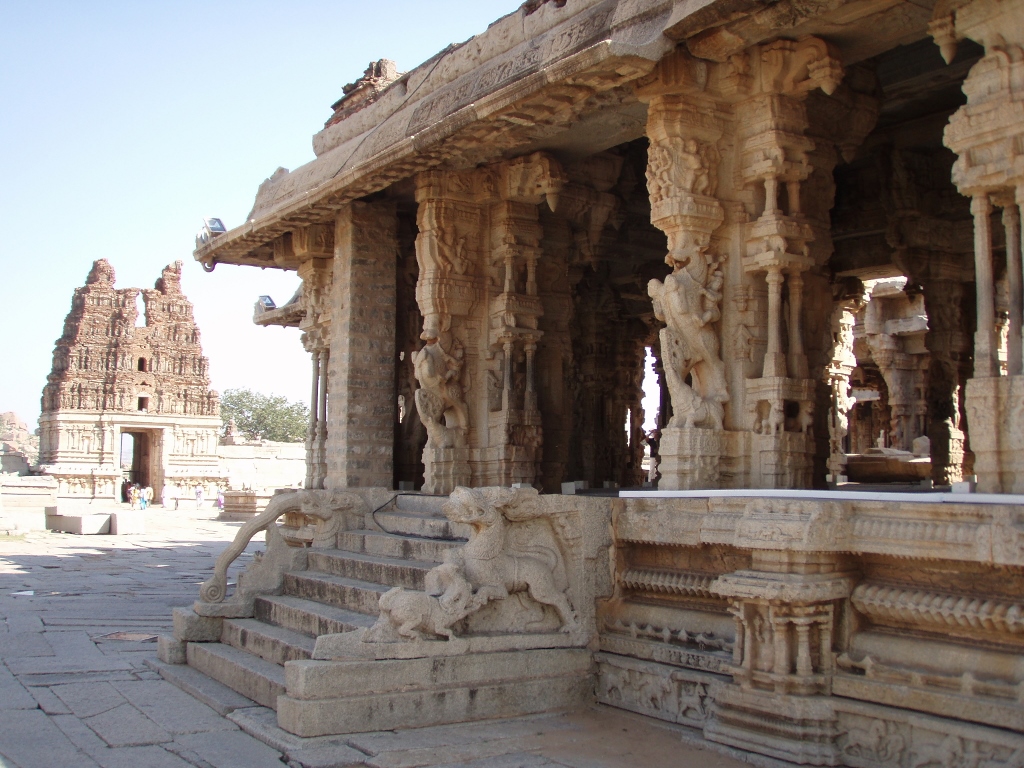 Vitthala Temple; main entrance with the gopuram and the central temple (there are the yalis here as well)
Vitthala Temple; main entrance with the gopuram and the central temple (there are the yalis here as well)
Since I took these photos following the detailed visit to the temple complex, after my camera battery had been charged, Sneža was waiting for me while I made a brief circle around the main temple. Thus I asked some other visitors to take a photo of me beside the Stone Chariot.
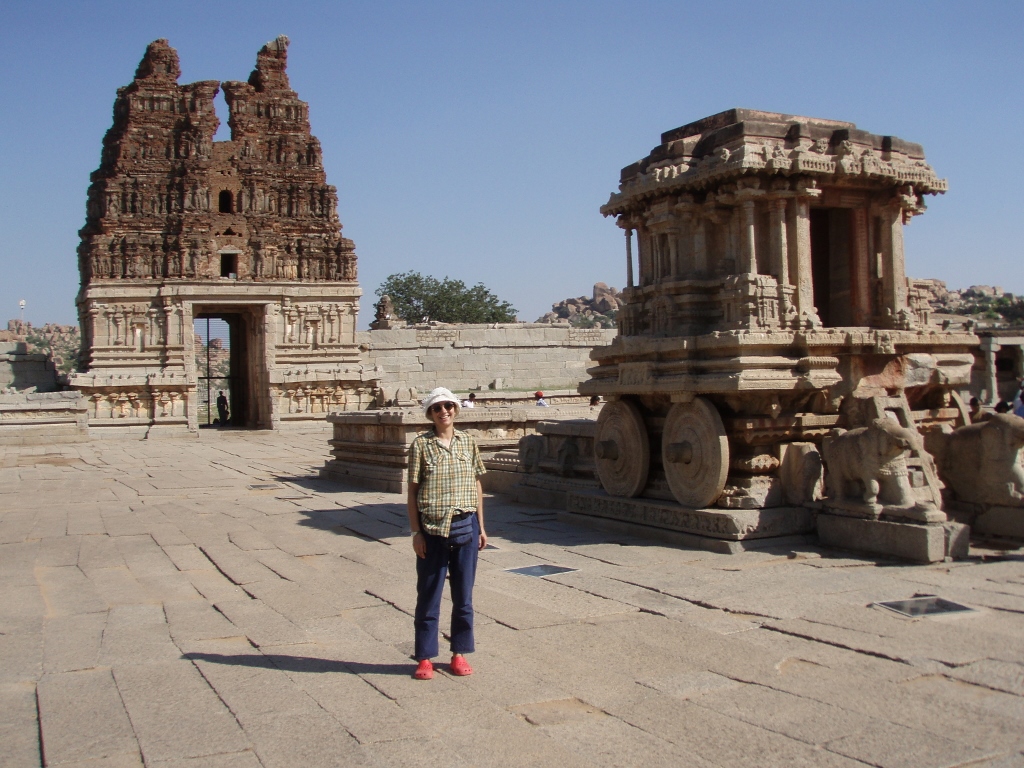 Me at Vitthala Temple; main entrance with the gopuram and the Stone Chariot
Me at Vitthala Temple; main entrance with the gopuram and the Stone Chariot
The only thing left to see now was the King’s Balance. This was where the kings had their weight measured and then they would distribute the same weight in grains to their subjects. This was actually how they justified their lack of measure related to food, because it would be better for the people if their rulers were fat.
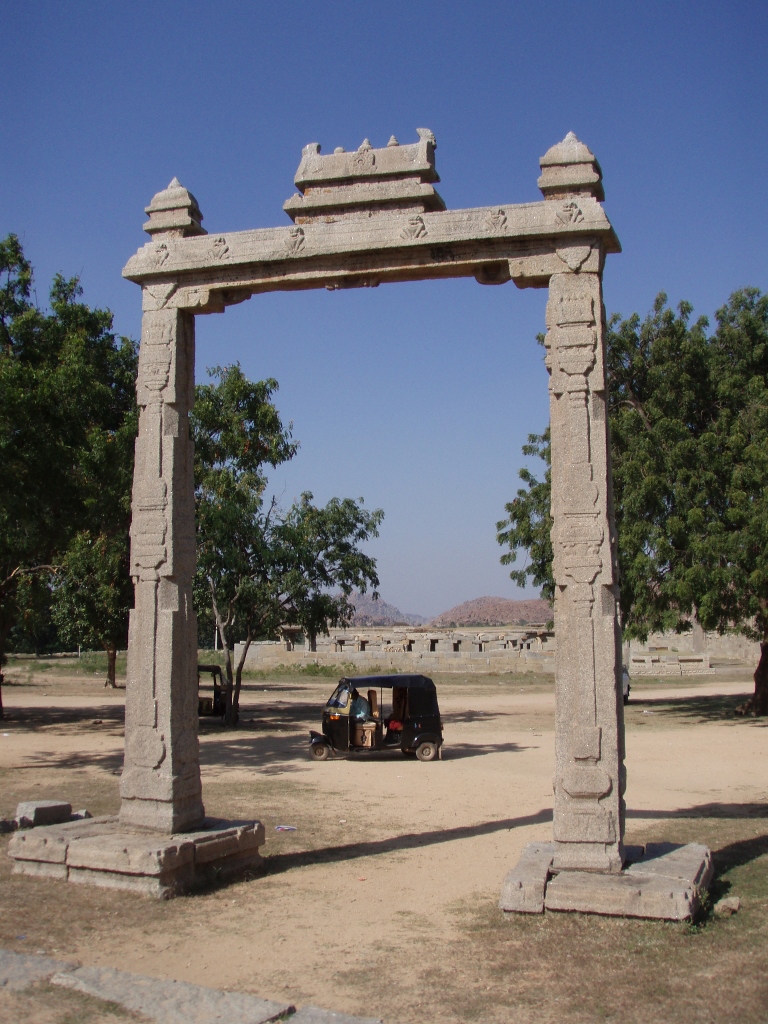 King’s Balance and our auto rickshaw
King’s Balance and our auto rickshaw
This was where we finished with our visit to Hampi. There is a large number of smaller temples also at this site, but their detailed sightseeing would require at least a couple of days. As my final action here, I looked back once again at the Tungabhadra river and the “giants’ gravel” that is so typical of this area.
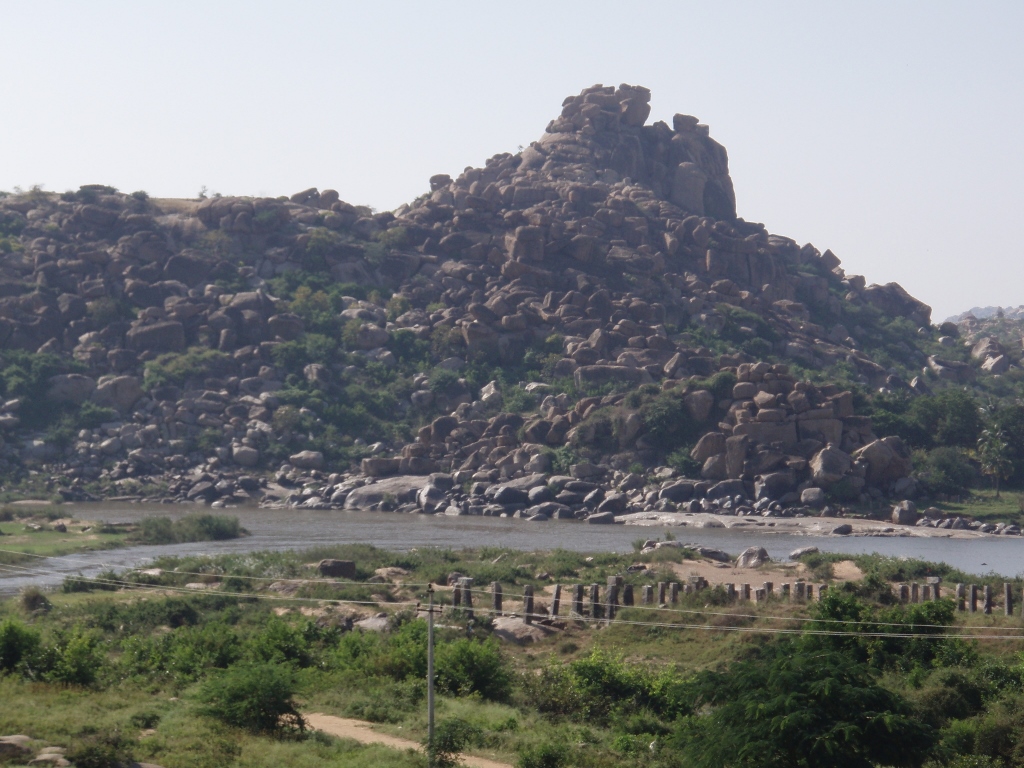 The Tungabhadra and the surroundings
The Tungabhadra and the surroundings
After all of this sightseeing we returned to Hospet to the office of the coach operator where we had left our backpacks. There we also continued hanging around with the two Italian women we visited Hampi with. They were very nice and kind, and one of them had already been to India many years ago and it could be seen that she had given herself a mission to introduce this amazing country to all the people she was with. Since we were all hungry by this time, the next thing to learn about from her was food. Thus we went to quite an ordinary restaurant and there we ordered “thali.” This is the cheapest Indian food and one portion is enough to feed two persons with the average level of hunger. On a large metal platter we got different Indian breads, rice and several dishes served in small bowls. We even got a serving of yoghurt and a dessert. It was all very tasty, but I did not eat too much, since I was still worried about the food poisoning of a couple of days before. The price of a thali (Sneža and I shared one and we even had some food left in the end) and 1 litre of water was 50 rupees, which was less than 1 euro!
Afterwards the Italians suggested we went to have Indian tea together and this is where a major love affair of mine started and it involved the masala chai, which means mixed spices tea. That tea which is the most frequently consumed beverage in India, after water, is made by putting black tea into milk and boiling it with a lot of sugar and many different spices. This involves cardamom, cinnamon, ginger, black pepper and cloves, and this is all incredibly tasty. At the beginning of our stay in India, Sneža and I were not too keen on eating food sold in the streets, but the masala chai is a completely safe non-alcoholic drink even for the very beginners for India. Namely, since it is boiled in milk, it can easily be seen if the milk is bad or not. If the milk is ok, then the tea is completely safe.
After the tea break, the four of us walked a little around and then we parted. The two Italians were to return that same night to Goa by coach (practically by the same coach all four of used the night before to get here from Goa), while Sneža and I finally took our backpacks and went to the hotel which coincidently happened to be just across the street.
Then the two of us came out again and went to an agency where we bought train tickets for the following night when we planned to move on as a part of our Indian journey. Along the way, we also agreed with a taxi driver to go on an excursion the following day, so then we went back to our hotel room where we could finally relax and get some decent rest. After the showers, we both went to bed very early.
We spent a few days in the federal state of Karnataka and during this time we visited the following destinations:
The reason for this is that around Hospet, in addition to the site of Hampi, there are also a few other very important and exceptionally beautiful sites and temples, so the next morning we got up quite early as we were going on a day’s trip to some of them that are rather off the beaten tracks. We left the hotel around 7.30 am and returned around 7 pm. We had agreed quite a decent car for this type of an excursion and the driver was very nice. He stopped or slowed down whenever we wanted to take photos and he also explained everything he could.
Even the very driving and watching India through the windows was fun and interesting enough. Thus we came across some people who were sweeping something that was on the road, while the vehicles slowed down significantly in such spots.
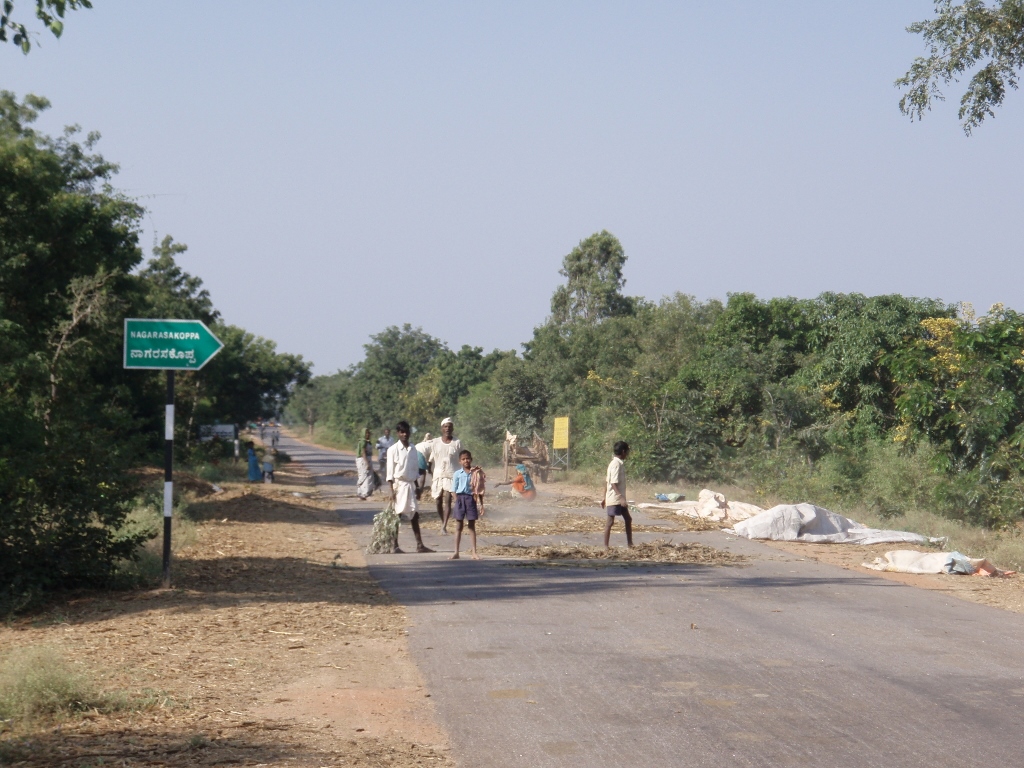 On the road from Hospet to Badami
On the road from Hospet to Badami
At first we found this to be quite odd and then we realised that people were doing the threshing in this way. They put the grains on the road and then vehicles drive over the grains and crushed them with their weight, after which it is easier to separate the seeds and the husks and straw. This was also confirmed by our driver and at some point he even made a stop in order to get a piece of the grain to show it to us. This was pearl millet. So, even the car we were in helped with this threshing.
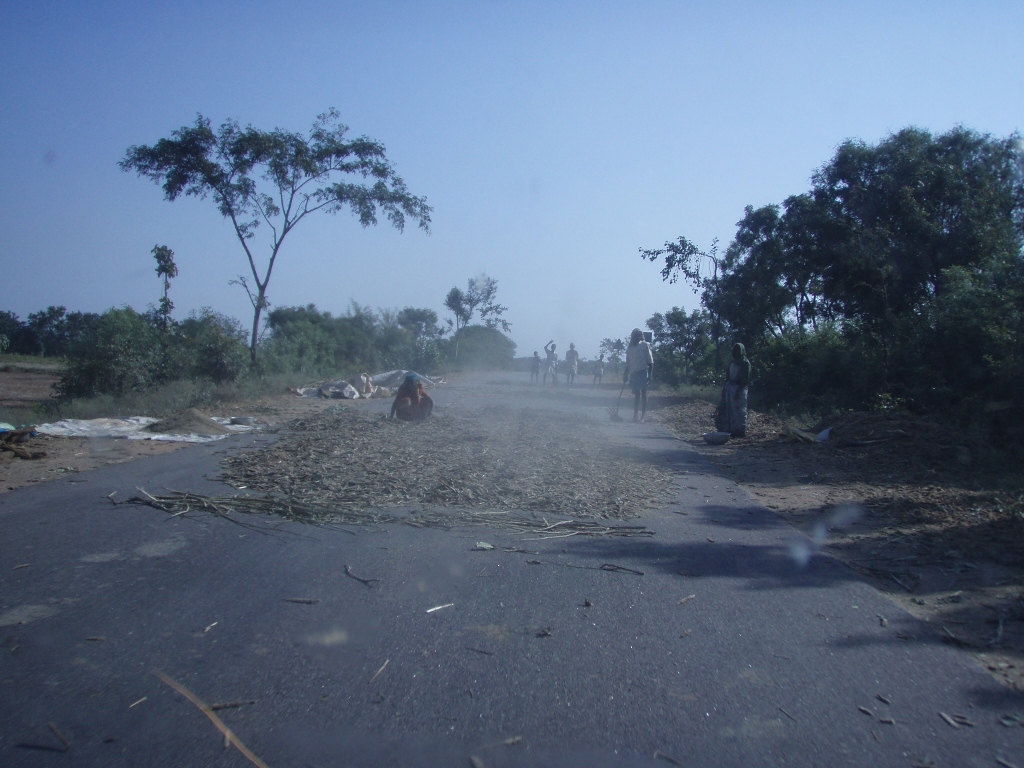 Our car has just driven over the grains
Our car has just driven over the grains
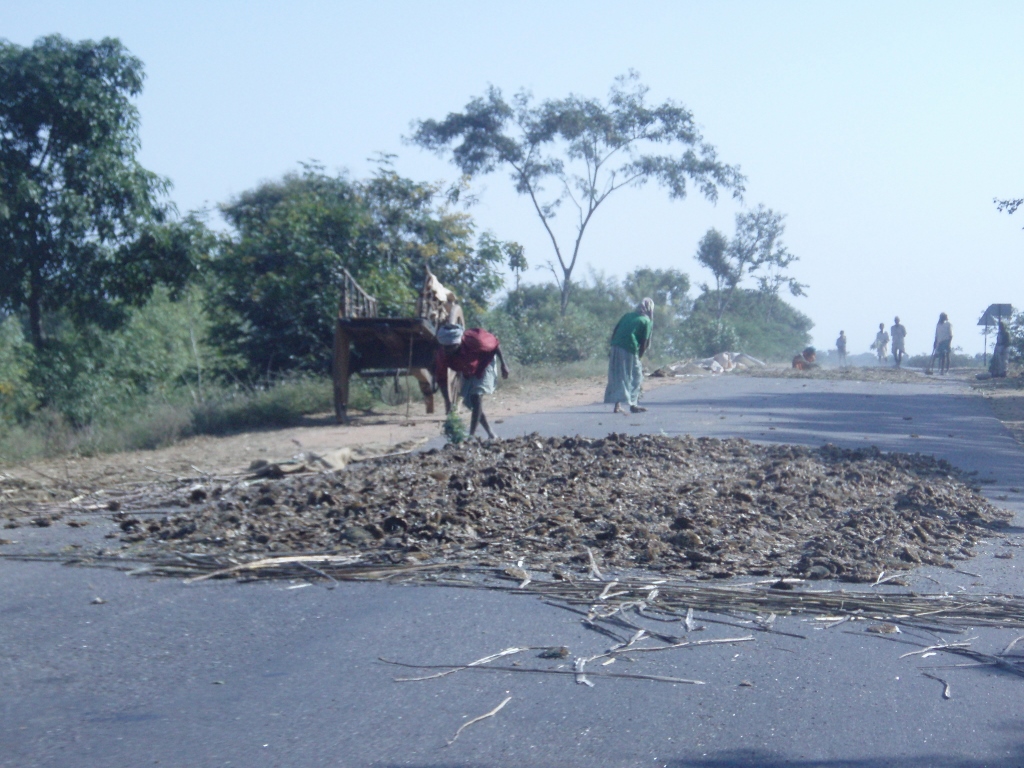 The threshing is done in several places
The threshing is done in several places
Along the way, in the places we went through, we could see oxen that had painted horns. The driver explained to us that each family has its own colour and thus everybody can know which animal belongs to which family.
But, on our way we also saw some other interesting things. For instance, women who carried big bundles of some grass on their heads. Perhaps this was not too heavy, but to carry something that bulky for obviously a long period of time, since there were no inhabited places in sight, must be very hard.
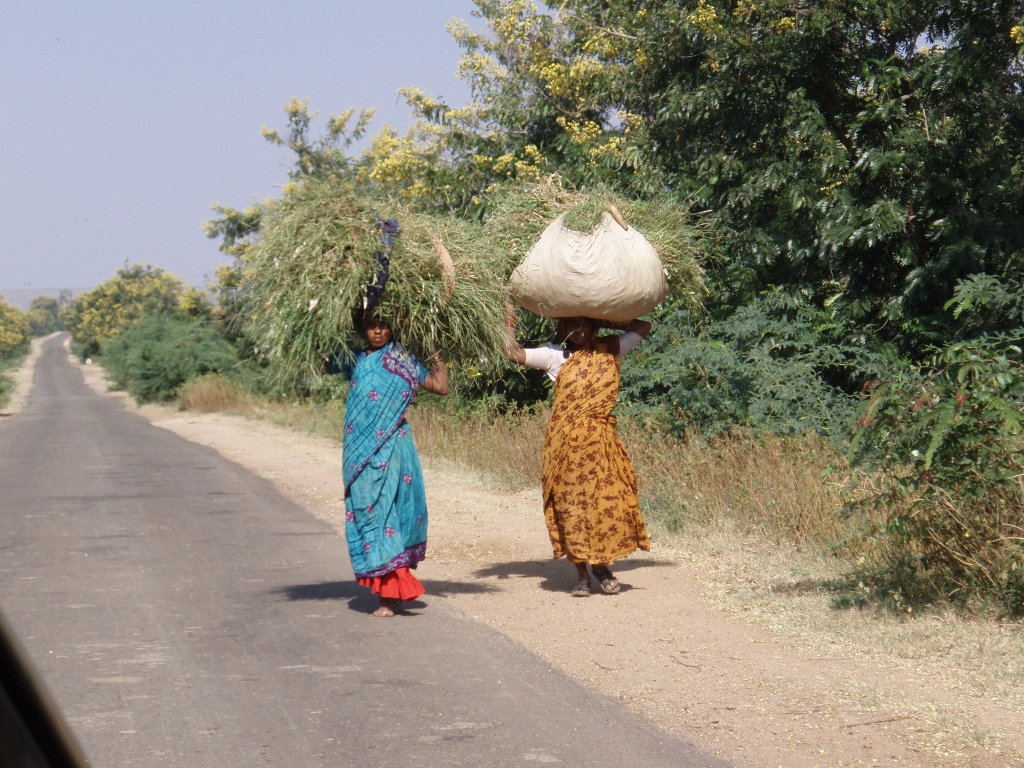 When there is nobody there to help, let’s put this on our heads
When there is nobody there to help, let’s put this on our heads
And we also saw something which I think people often link to India – overcrowded vehicles. Only this time around, this was not a train, but a regular small van.
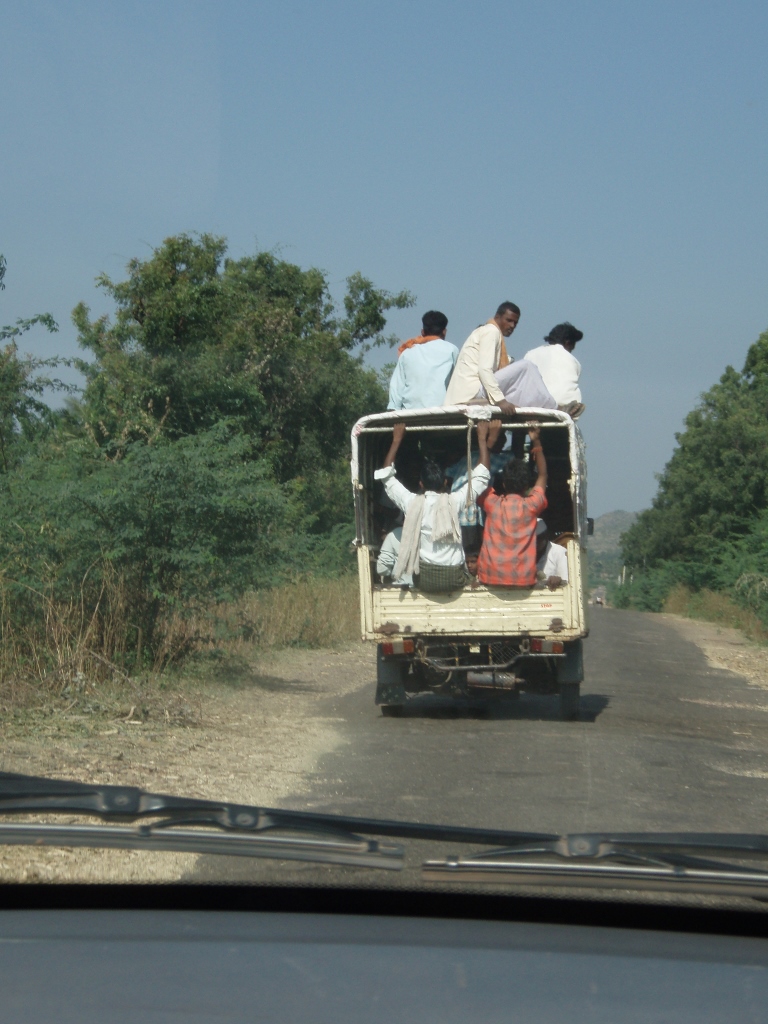 Transportation can be done like this as well
Transportation can be done like this as well